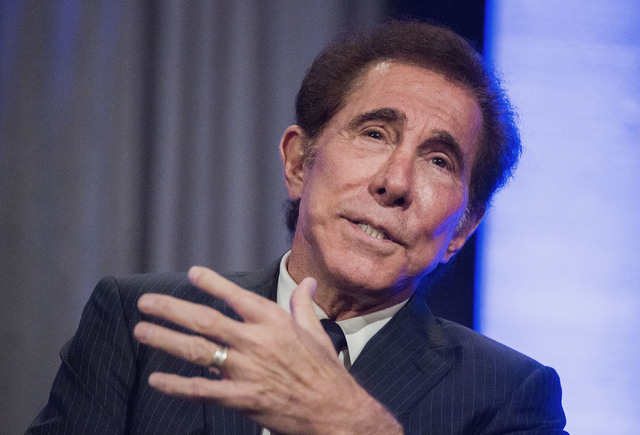Conference brings out tales of historic opening of The Mirage

With several presentations vying for attention at the same time at last week’s 16th International Conference on Gambling and Risk Taking, it wasn’t too surprising that it was a small and mostly local crowd that showed up to hear four panelists talk about opening day at The Mirage more than 25 years ago.
Wynn Resorts Ltd. Chairman Steve Wynn had just dazzled the more than 600 people from 30 countries attending the event with a keynote speech that addressed his views on the phenomenon known around the world as “integrated resorts.”
We know them around here as megaresorts, generally a hotel of more than 3,000 rooms with a variety of supporting attractions, all built around a casino.
Wynn made a rare public appearance at the conference at The Mirage, the hotel-casino he opened Nov. 22, 1989, that forever changed Las Vegas’ landscape and, for that matter, casinos worldwide.
Las Vegas Review-Journal readers chimed in that The Mirage wasn’t the first resort built in Las Vegas in 25 years as initially reported — Caesars Palace, in fact, is looking at a 50-year anniversary later this year.
In his speech, Wynn paid tribute to Jay Sarno, who developed Caesars Palace and Circus Circus. But at the time of its opening, The Mirage was the biggest thing anyone had ever seen in Las Vegas and a property most critics believed wouldn’t be financially sustainable.
Even the panelists gathered for the session, “Reuniting the Opening Day Team from The Mirage Hotel Casino: How It Went Up and How It Went Down,” admitted they weren’t entirely sure what to expect, even though Wynn exuded confidence from the groundbreaking until the day before the opening.
Panelist Dennis Amerine, who was a state Gaming Control Board member when The Mirage opened, said leading up to licensing, “we had serious concerns about whether this made any sense.”
Wynn was counting on The Mirage’s dazzling amenities to draw big crowds to drive revenue. He was able to hire the best people available because there were 55,000 applicants for 6,000 jobs and Wynn was counting on them to face any crisis with a smile to keep customers happy. That’s a big part of the Wynn secret sauce — to find employees who interact well with guests.
Panelists recalled that Wynn showed an uncharacteristic lack of confidence on the day before the doors opened, contemplating running an advertisement in the Review-Journal inviting the public to the opening. After all, is it really a party if nobody shows up?
On opening day, an estimated 35,000 poured into the building and 35,000 more people were in cars on the streets leading to the property.
The place was jammed; people couldn’t move around. Then, somebody hit a Megabucks jackpot and a new level of pandemonium ensued.
“It was a zoo, it was absolute chaos,” said Alan Feldman, a part of the opening-day team and now an executive vice president with MGM Resorts International.
Feldman noted that Wynn may have inadvertently built some pent-up demand as a result of his policy of not showing anything to the public before opening day. It’s a policy Wynn has used for every resort he has opened in Las Vegas.
Because everybody wanted to see what The Mirage looked like inside, crowds overwhelmed the place when the doors finally opened.
Feldman also shared an opening-day muff related to keeping the media at bay before the opening.
After a preopening press conference at which media weren’t invited inside, some reporters and videographers from Channel 13 were hanging out near a security area before leaving. A security guard, focused on keeping the customer happy, invited the media team inside where it got footage of the casino’s insides before anyone else. It ran on a 5 o’clock newscast and Feldman said he politely asked the station not to run it again, applying a little subtle pressure about future access.
The footage didn’t run in later broadcasts and Feldman said the security guard didn’t get fired because of his mistake.
Other takeaways from last week’s conference focus on integrated resorts: We’re destined to have one in town in 2019 when the Malaysia-based Genting Group opens its $4 billion, 3,100-room Chinese-themed Resorts World Las Vegas property on the Strip’s north end.
And, watch for foreign resorts to grow more competitive with Las Vegas, particularly in Asia.
Bo Bernhard, executive director of UNLV’s International Gaming Institute, said Macau is having a new growth spurt, driven partly by the “Las Vegasization” of its properties — in other words, Macau is buying into the theory that it will take more than gambling to attract the emerging Chinese mass market and property designers are delivering more amenities.
Macau has thrived and survived thanks to high-rolling Chinese gamblers who contributed to record earnings until about two years ago, when a crackdown on corruption stalled growth.
We’ll all be watching to see what Las Vegasization will do next.
Contact Richard N. Velotta at rvelotta@reviewjournal.com or 702-477-3893. Find him on Twitter: @RickVelotta